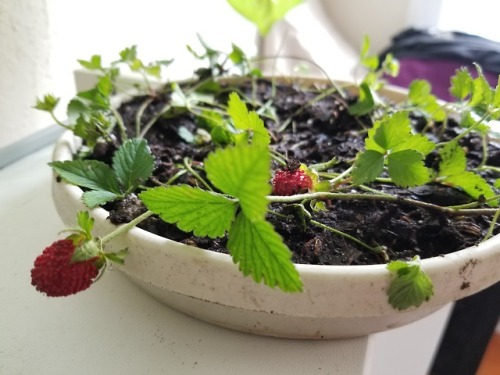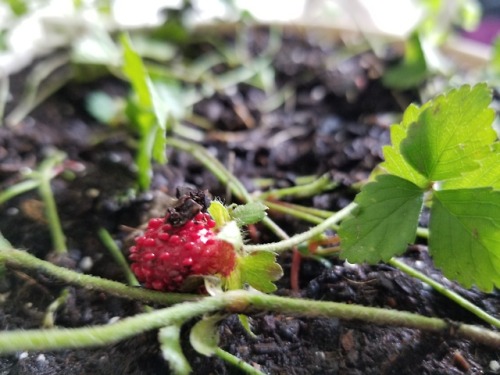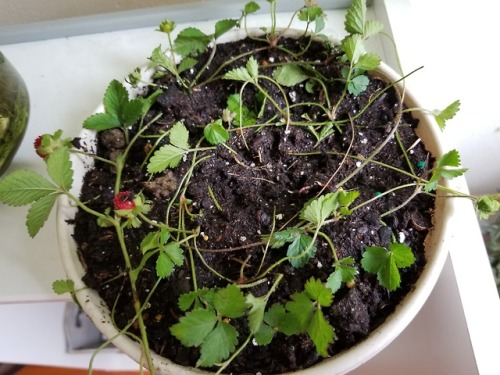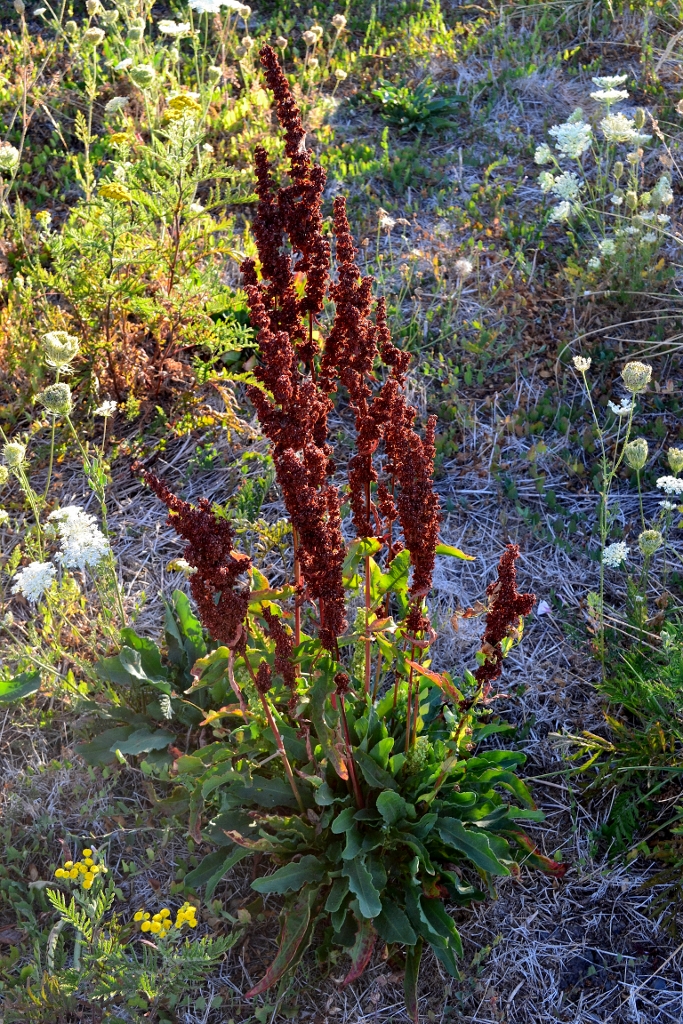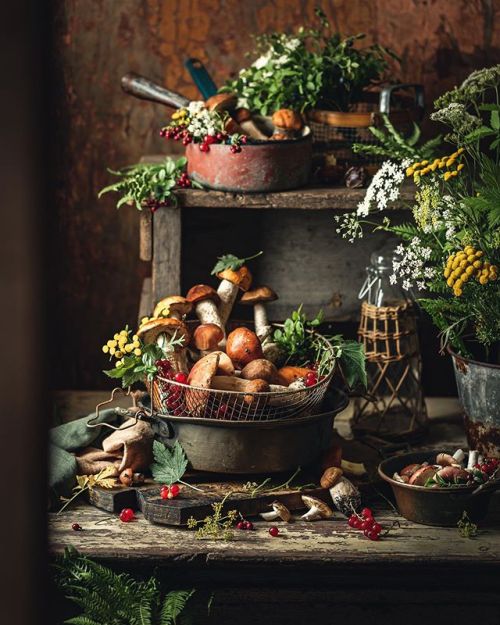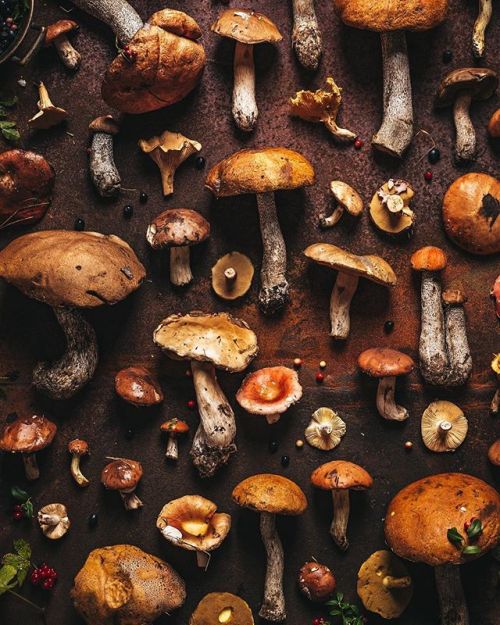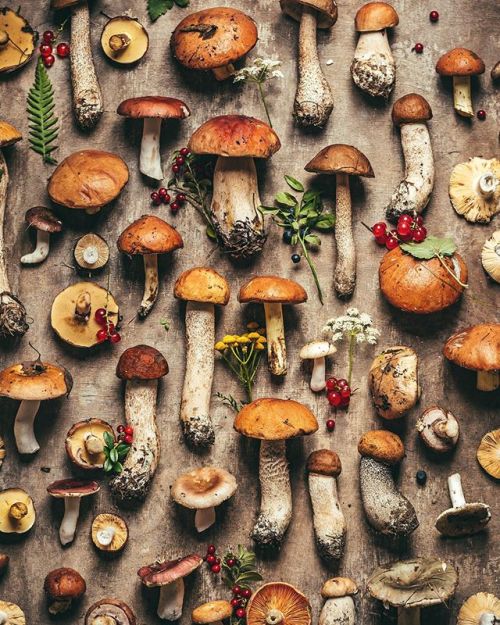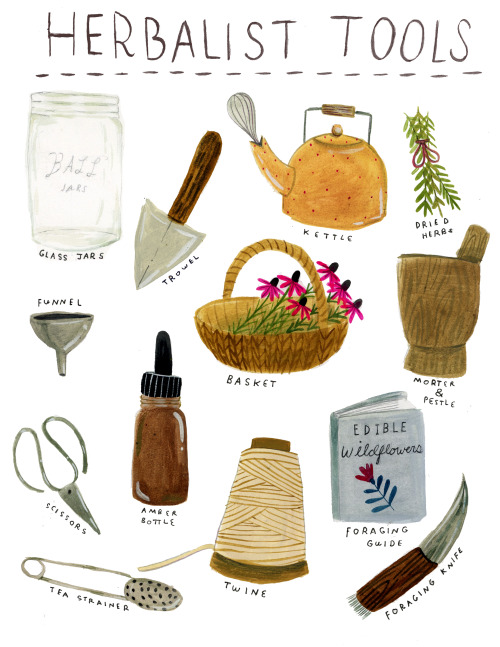#forage
May or may not have caved and snagged a handful of wild strawberries from the park today.
Doing a little cultivation experiment before committing to trying a larger haul in a bigger pot/dish.
I figured since they don’t seem to have particularly long roots, I’d just use a spare base from my planters and fill it with loose soil. After getting them semi buried, I gave the soil a heavy spritzing of water to mimic how wet the soil was outside.
With any luck they’ll take root and possibly flower (ideally they’ll get strong enough that I can put the whole thing back outside and let them get pollinated this season, but even if not, they’ll be pretty).
Post link
I found these beautiful pink flowers blooming on our beach property.
The tree is Madero Negro and the flowers are edible (!!) and although the leaves are not, they can be used as a natural insecticide when crushed and soaked in water.
The tree is also used as a living fence and is very beneficial as it fixes nitrogen in the soil.
Post link
What’s your favorite knife for picking mushrooms? .
Our buddy Jack is sitting with a bag of Hedgehogs & Chanterelles last March with my Rosewood handled custom knife & his little @kershawknives Leek Pocket Knife. .
#knivesarefun #favoriteknife #forage #forager #mushrooms #hongos #sporelust #chanterelle #cantharellus #hedgehogs #oregon #oregonmade #casxademade #crvdpls #mushroomhunting #mycology #mycophile #oregoncoastrange (at Oregon)
https://www.instagram.com/p/Bs8nrd-HE2D/?utm_source=ig_tumblr_share&igshid=8zog4udnx0m8
Post link
#bouquet #nontraditionalbride #mushroom #mushroomhouse #naturelover #nature #walkingthedog #mushrooms #forager #forage #minneapolis #uptown #uptownminneapolis
Post link
Forage grass is the basis for raising cattle. It not only contains various nutrients necessary for cattle, but also contains crude fiber that is particularly important for maintaining cattle health. This is irreplaceable by grain and other feeds. High-quality forages can completely satisfy cattle’s nutrition.If it is not in the production or fattening period, there is generally no need to supplement the concentrate.
Matching method of forage
Cattle prefer to eat gramineous forages and tall plants, followed by leguminous forages. Forage varieties suitable for feeding cattle include hybrid pennisetum, sudangrass, alfalfa, pine herb, Dongmu-70 rye, chicory and rutabaga. Dairy cows generally require 50 kg of green fodder per head per day, and mixed herds including young cattle and calves require an average of 30 kg of green fodder per day. To ensure an uninterrupted supply of green fodder throughout the year, annual forages and perennial forages, tropical forages and temperate forages should be planted together, and single species and intercropping should be combined as much as possible per unit area.
Morning forage and a starry shirt I made. #blackcaps #raspberries #forage #Wisconsin #driftless #berries #wild #fabric #sewing #pattern #stars
Post link
Hi Folks!
I am very excited to announce the release of this second print of The Northwest Forager’sPocket Guide to Wild Edible Plants!
Now with new features! Introducing the “found it!” check box for each plant, easy flip through color coded categories, and extra field note pages to record your findings for future reference.
This true pocket-sized guide (Measuring 3.5″ x 5″) features 26 of the Pacific Northwest’s most common and easy to identify edible plants as well as 5 hazardous look-alikes. It’s convenient size and easy-to-use format make this the ideal field guide to take with you in all your northwest adventures! Never go hiking, camping or hunting again without being prepared to explore the wild flavors of nature’s produce.
How to Use this Guide
The contents have been divided into three categories (Leafy Vegetables, Root Vegetables, Fruit Berries). The plants in each category have been arranged according to seasonal availability. There are two pages per plant. The 1st displays the plant in its natural growing environment and lists information such as its scientific name, growing habitat, as well as when and what parts to use. The 2nd notes basic info such as history, preparation, and nutritional value. It also displays specific edible parts as well as identifiable features. Plants with a common poisonous look-alike will be referenced in the back of the guide.
Table of Contents
Leafy Vegetables
- Bittercress
- Stinging Nettle
- Chickweed
- Siberian Miner’s Lettuce
- Wood Sorrel
- Lady Fern
- Plantain
- Cat’s Ear
- Nipplewort
- Broadleaf Dock
- Oxeye Daisy
- Lambs Quarter
- Purslane
Root Vegetables
- Dandelion
- Wild Onion
- Cattail
- Queen Anne’s Lace
- Field Mustard
- Burdock
- Camas
Fruit Berries
- Salmonberry
- Huckleberry
- Thimbleberry
- Salal
- Huckleberry Evergreen
- Elderberry
How to Order your Copy
Available on,
For purchases outside of the United States please use the followingeBaylink
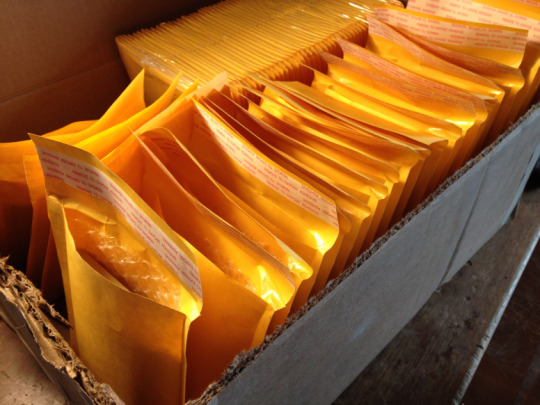
A huge thank you to everyone who has ordered a copy! We are truly grateful for all the support shown :]
Please help other customers decide if this book is right for them by leaving a review in the comment box below.
Now Available! Pocket Guide to Wild Edible Plants Hi Folks! I am very excited to announce the release of this second print of The Northwest Forager's…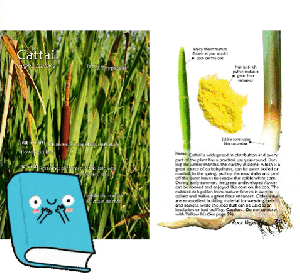
Hi Folks,
I am very excited to announce the launch of our Kickstarter campaign starting Saturday, May 23, 2020! The goal of this campaign is to raise the funds needed to print another batch of my book: The Northwest Forager’s Pocket Guide to Wild Edible Plants. This is an exciting opportunity for everyone who makes a pledge.
- $1 gets your name credited in this print.
- $15 gets you your own personal…
Hi Folks!
I am very excited to announce the release of The Northwest Forager’sPocket Guide to Wild Edible Plants! This true pocket-sized guide (Measuring 3.5″ x 5″) features 26 of the Pacific Northwest’s most common and easy to identify edible plants as well as 5 hazardous look-alikes. It’s convenient size and easy-to-use format make this the ideal field guide to take with you in all your northwest adventures! Never go hiking, camping or hunting again without being prepared to explore the wild flavors of nature’s produce.
How to Use this Guide
The contents have been divided into three categories (Leafy Vegetables, Root Vegetables, Fruit Berries). The plants in each category have been arranged according to seasonal availability. There are two pages per plant. The 1st displays the plant in its natural growing environment and lists information such as its scientific name, growing habitat, as well as when and what parts to use. The 2nd notes basic info such as history, preparation, and nutritional value. It also displays specific edible parts as well as identifiable features. If a plant has a common poisonous look-alike, it will be referenced in the back of the guide.
Table of Contents
Leafy Vegetables
- Bittercress
- Stinging Nettle
- Chickweed
- Siberian Miner’s Lettuce
- Wood Sorrel
- Lady Fern
- Plantain
- Cat’s Ear
- Nipplewort
- Broadleaf Dock
- Oxeye Daisy
- Lambs Quarter
- Purslane
Root Vegetables
- Dandelion
- Wild Onion
- Cattail
- Queen Anne’s Lace
- Field Mustard
- Burdock
- Camas
Fruit Berries
- Salmonberry
- Huckleberry
- Thimbleberry
- Salal
- Huckleberry Evergreen
- Elderberry
How to Order your Copy
For a limited time, there will be free shipping within the United States!
Purchase securely via your account or debit/credit card through PayPal.
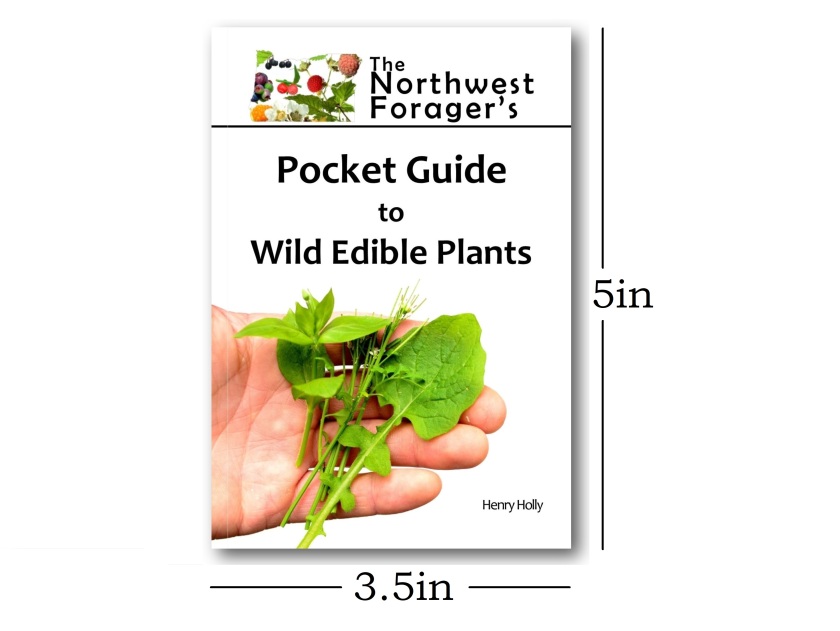
The Northwest Forager’s Pocket Guide to Wild Edible Plants
(1 Book) 68 pages, 100 color photos, 26 wild edible plants that include their Greens, Flowers, Roots, Seeds & Berries, plus 5 poisonous look-alikes, Elevation Map of Pacific Northwest, Measures 3.5″ by 5″ (truly pocket size), ISBN 978-0-692-07826-6, Text & Photographs by Henry Holly, Copyright 2018, Published by The Northwest Forager, Printed by Lightning Press, NJ (USA).
$12.95
For purchases outside of the United States please use the followingeBaylink.
To purchase by Check or Money Order within the United States please make a payment in the amount of $12.95 and mail to: The Northwest Forager Henry Holly PO BOX 55 Crabtree, OR 97335

Please help other customers decide if this book is right for them by leaving a review in the comment box below.
New Release! Pocket Guide to Wild Edible Plants from The Northwest Forager Hi Folks! I am very excited to announce the release of The Northwest Forager’s Pocket Guide to Wild Edible Plants…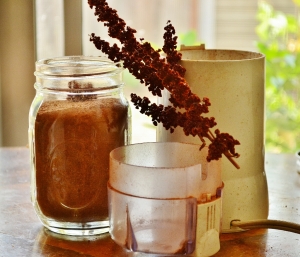
Dock (Rumex) consist of a variety of edible plants found over most of the Earth. Two of the most commonly known varieties is Curly Dock and the Broad-leaved Dock. Typically it’s the vitamin-rich leaves which are most often enjoyed. In today’s article, however, we will consider the use of Dock’s seeds.
Curly Dock – Rumex crispus
Dock is both protrusive and wide-spread in its distribution. Therefor…
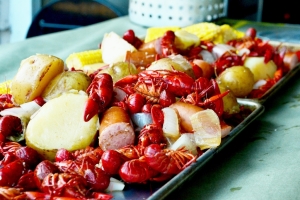
Arthropods and Crustaceansaka Water Bugs! In the western civilization that’s typically not our idea of a lip smacking entrée. However, add some Cajun sauce, sliced potatoes, corn and sausage, boiled with 5lbs of Crawfish, and that’s just what you get. A lip smacking, shell cracking, disemboweling, finger licking water bug dinner. Sound disgusting or maybe even barbaric? Try both. Even so that…
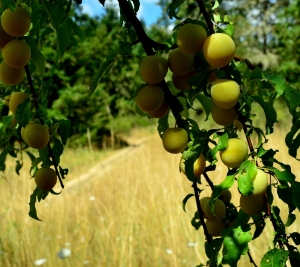
When harvest is abundant, Fruit liquors are a fun and tasty way to enjoy the extra fruit hanging around. In this article we’ll go over 5 easy steps in preparing fruit liquor with the fruit of your choice.
IngredientsStep 1 – Choosing the fruit
- Fresh Fruit
- Sugar
- Vodka or Tequila
Pick a fruit that is fully ripe, full of juice, and can easily be packed into a jar without crushing. In this case,…
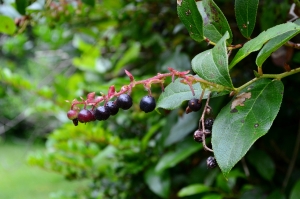
Gaultheria shallonA Salal shrub (Gaultheria shallon) well established on a piece of drift wood as commonly seen along the Oregon coast.
Salal berry could be perhaps one of the most widely abundant and under appreciated wild fruits of the Pacific Northwest. Common along coast lines, coniferous forest, logging roads, and river banks, Salal is a delightful treat that can be enjoyed during most…
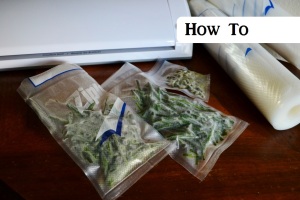
We wait all year for our favorite delicacy to come into season only to watch it spring, mature and wither before our very eyes. Living in the high speed world of today we’re fortunate just to get a taste or two while it’s still in its prime. So unless one is a fulltime “hunter and gatherer”… initiating methods of food preservation is a must if we are to capture the seasonally fresh flavor of…
One of my favorite aspects of practice herbalism is all of the tools that go into making the process special. I find that a lot of tools are ones that can be found around the house like twine, scissors, a tea kettle, etc. But the as time has gone on, I’ve enjoyed collecting ones that inspire me to want to be using them more often. This is by means not a comprehensive list of tools that can be used while foraging or practicing herbalism, but some of the most basic, especially for beginners
Post link
While winter isn’t the most exciting time to forage, there are some subtle preserved beauties out there to find. Some of my favorites are making tea with conifer leaves and turkey tails, jams from the mushier rose hips, and collecting frozen sap. What’s your favorite foraged finds during the cold season?
Post link
TIPS FOR MUSHROOM FORAGING: I first learned how to forage when I was living on a cow farm for a summer. A few nights a week, one of the farmers and I would go out and he’d show me how to I.D. edible mushrooms and plants. I am not an expert mycologist by any means, but foraging mushrooms has become one of the great joys of my summers. Here’s a few tips that I’ve learned (or been taught) over the years. While everyone has different style, my go to is safety comes first. No mushroom is so tasty its worth dying over.
Get to know a few safe, and easy to I.D. species: this is key. It can be overwhelming first getting started seeing mushrooms and thinking, can I eat that? I recommend starting with just a few to really get to know and build your comfortability and confidence from there.
When in doubt, just leave it: If you can’t confidently I.D., I wouldn’t suggest eating it. If you’re interested in learning more, you can always take it home, spore print it, do some research, etc., but I would be weary of eating something you’re not totally sure about.
Think about look-a-likes, season, habitat, and bioregions: this is a big one. Asking yourself questions like “would this mushroom grow near this kind of tree, water source, this time of year?” Can give context clues to whether or not this is the mushroom you’re looking to find.
Learn how to use field guides: While the internet is a vastly helpful place, look to field guides to give the best context about different species and look-a-likes.
Always leave some behind: Like in any foraging practice, be respectful. Especially with mushrooms, by leaving some behind you may have a perennial spot to look for the next year.
Post link

